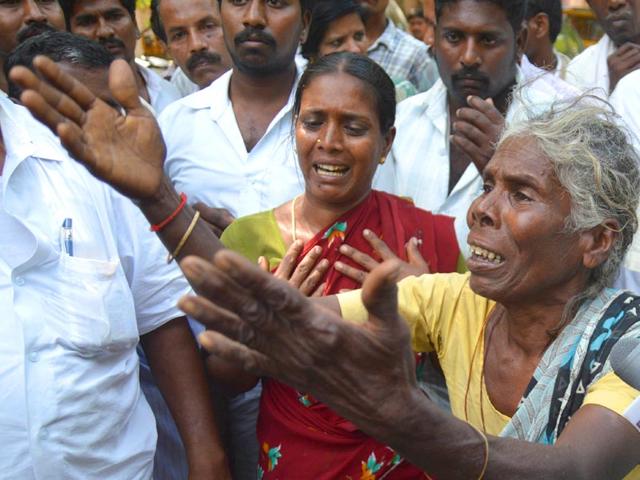Lopsided forest protection laws force poor people into illegal logging
Twenty suspected red sander (red sandalwood) “smugglers/loggers/woodcutters” were killed by the Red Sanders Anti-Smuggling Task Force in Andhra Pradesh’s Chittoor district on Tuesday. The police claim that its men were attacked by a group of 100 smugglers with stones and sickles and their response was purely in “self-defence”. But activists are refusing to buy this theory and are demanding an inquiry into the deaths.
Twenty suspected red sander (red sandalwood) “smugglers/loggers/woodcutters” were killed by the Red Sanders Anti-Smuggling Task Force in Andhra Pradesh’s Chittoor district on Tuesday. The police claim that its men were attacked by a group of 100 smugglers with stones and sickles and their response was purely in “self-defence”. But activists are refusing to buy this theory and are demanding an inquiry into the deaths.

This is not the first of such encounters in the red sander-rich jungles of south India but Tuesday’s incident is the highest toll in a single encounter in the history of red sander smuggling. Despite trying hard for years, red sander-rich states like Andhra Pradesh and Karnataka have failed to check smuggling of the commercially lucrative trees, which is valued for the rich red colour of its wood.
According to reports, police have arrested more than 3,500 people in over 4,500 cases of red sander smuggling since 2004. An Andhra Pradesh forest official told Down To Earth magazine that most jails in the Rayalaseema region, which includes Chittor, have a high number of red sander smugglers.
Despite arrests and deaths, dirt poor forest-dependent communities end up joining these illegal gangs because of three reasons: First, they have no professional skills to get a job; second, high price of red sandalwood in foreign markets makes illegal a lucrative option; and, third, India’s lopsided forest and wildlife protection laws that take away from poor people their means of existence, in the name of nationalisation of certain trees like sandalwood, forcing them to take the illegal and dangerous route.
Here is what ‘nationalisation’ of trees means: Every sandalwood tree belongs to the State. This means that you may own the land but the economic benefit of harvesting sandalwood trees would always go to the State. In other words, the State reserves the right to sell the tree.
So when poor people cannot legally own and use a valuable resource and have no other means to fill their stomachs, they become easy targets for groups that are into illegal felling.
This is not all: A farmer has to inform the forest authorities if he has a sandalwood tree on his land but that doesn’t mean the forest department will take over the maintenance of these trees. The responsibility for the care of the tree lies with the farmer. If there is a theft or a tree dies, he is expected to report the matter to the department.
And when the government decides to cut the tree, the farmer gets 75% of a price determined by the forest department, which is not as high as the prevailing market price; the disbursal process is also time-consuming.
Most farmers pluck out sandalwood saplings to avoid government harassment. This has ensured few sandalwood trees are now left outside the State-controlled forests. Moreover, since forests are State properties, the income generated from selling these ‘nationalised’ trees are not shared with the local communities.
The end result of this alienation of the communities from the forests - and the State - is not even smuggling. It is far worse: The isolation caused by the forest laws has brought large tracts of these areas under the influence of insurgent groups.
There was a policy change in Karnataka and Tamil Nadu in 2001 and 2002 respectively that allowed people to grow sandalwood. This inspired other states. In the past four years, 2,800 ha of agricultural land came under sandalwood cultivation in Gujarat, Andhra Pradesh, Madhya Pradesh, Maharashtra and Uttarakhand, apart from Karnataka and Tamil Nadu. The figure is rising by 600 ha per year, according to an estimate by the Institute of Wood Science and Technology (IWST), Bengaluru, a pioneering institute for sandalwood research.
But this has not benefitted the poor much. First red sanders is a slow-growing tree and so immediate financial needs cannot be met quickly; second, farmers need to invest heavily in protection equipment and third, the growers are left at the mercy of private procurers who cheat and bully the producers. Last but not the least, a large section of tribals, like those killed in Chittor, are landless and so are lured by smugglers for cutting trees. Tamil Nadu does not have a law that protects lands of tribals. Tribals in the state are exploited and their lands are being bought by outsiders.
These foot soldiers are just small pawns in a larger smuggling racket. The gangs and their leaders are never caught because they have strong linkages with police, politicians and forest officials.





